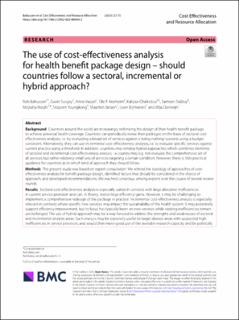| dc.contributor.author | Baltussen, Rob | |
| dc.contributor.author | Surgey, Gavin | |
| dc.contributor.author | Vassall, Anna | |
| dc.contributor.author | Norheim, Ole Frithjof | |
| dc.contributor.author | Chalkidou, Kalipso | |
| dc.contributor.author | Siddiqi, Sameen | |
| dc.contributor.author | Nouhi, Mojtaba | |
| dc.contributor.author | Youngkong, Sitaporn | |
| dc.contributor.author | Jansen, Maarten | |
| dc.contributor.author | Bijlmakers, Leon | |
| dc.contributor.author | Oortwijn, Wija | |
| dc.date.accessioned | 2024-03-11T09:38:44Z | |
| dc.date.available | 2024-03-11T09:38:44Z | |
| dc.date.created | 2023-10-26T10:57:18Z | |
| dc.date.issued | 2023 | |
| dc.identifier.issn | 1478-7547 | |
| dc.identifier.uri | https://hdl.handle.net/11250/3121739 | |
| dc.description.abstract | Background
Countries around the world are increasingly rethinking the design of their health benefit package to achieve universal health coverage. Countries can periodically revise their packages on the basis of sectoral cost-effectiveness analyses, i.e. by evaluating a broad set of services against a ‘doing nothing’ scenario using a budget constraint. Alternatively, they can use incremental cost-effectiveness analyses, i.e. to evaluate specific services against current practice using a threshold. In addition, countries may employ hybrid approaches which combines elements of sectoral and incremental cost-effectiveness analysis - a country may e.g. not evaluate the comprehensive set of all services but rather relatively small sets of services targeting a certain condition. However, there is little practical guidance for countries as to which kind of approach they should follow.
Methods
The present study was based on expert consultation. We refined the typology of approaches of cost-effectiveness analysis for benefit package design, identified factors that should be considered in the choice of approach, and developed recommendations. We reached consensus among experts over the course of several review rounds.
Results
Sectoral cost-effectiveness analysis is especially suited in contexts with large allocative inefficiencies in current service provision and can, in theory, realize large efficiency gains. However, it may be challenging to implement a comprehensive redesign of the package in practice. Incremental cost-effectiveness analysis is especially relevant in contexts where specific new services may impact the sustainability of the health system. It may potentially support efficiency improvement, but its focus has typically been on new services while existing inefficiencies remain unchallenged. The use of hybrid approach may be a way forward to address the strengths and weaknesses of sectoral and incremental analysis areas. Such analysis may be especially useful to target disease areas with suspected high inefficiencies in service provision, and would then make good use of the available research capacity and be politically rewarding. However, disease-specific analyses bear the risk of not addressing resource allocation inefficiencies across disease areas.
Conclusions
Countries should carefully select their approach of cost-effectiveness analyses for benefit package design, based on their decision-making context. | en_US |
| dc.language.iso | eng | en_US |
| dc.publisher | BMC | en_US |
| dc.rights | Navngivelse 4.0 Internasjonal | * |
| dc.rights.uri | http://creativecommons.org/licenses/by/4.0/deed.no | * |
| dc.title | The use of cost-effectiveness analysis for health benefit package design – should countries follow a sectoral, incremental or hybrid approach? | en_US |
| dc.type | Journal article | en_US |
| dc.type | Peer reviewed | en_US |
| dc.description.version | publishedVersion | en_US |
| dc.rights.holder | Copyright 2023 The Author(s) | en_US |
| dc.source.articlenumber | 75 | en_US |
| cristin.ispublished | true | |
| cristin.fulltext | original | |
| cristin.qualitycode | 1 | |
| dc.identifier.doi | 10.1186/s12962-023-00484-2 | |
| dc.identifier.cristin | 2188730 | |
| dc.source.journal | Cost Effectiveness and Resource Allocation | en_US |
| dc.identifier.citation | Cost Effectiveness and Resource Allocation. 2023, 21 (1), 75. | en_US |
| dc.source.volume | 21 | en_US |
| dc.source.issue | 1 | en_US |

